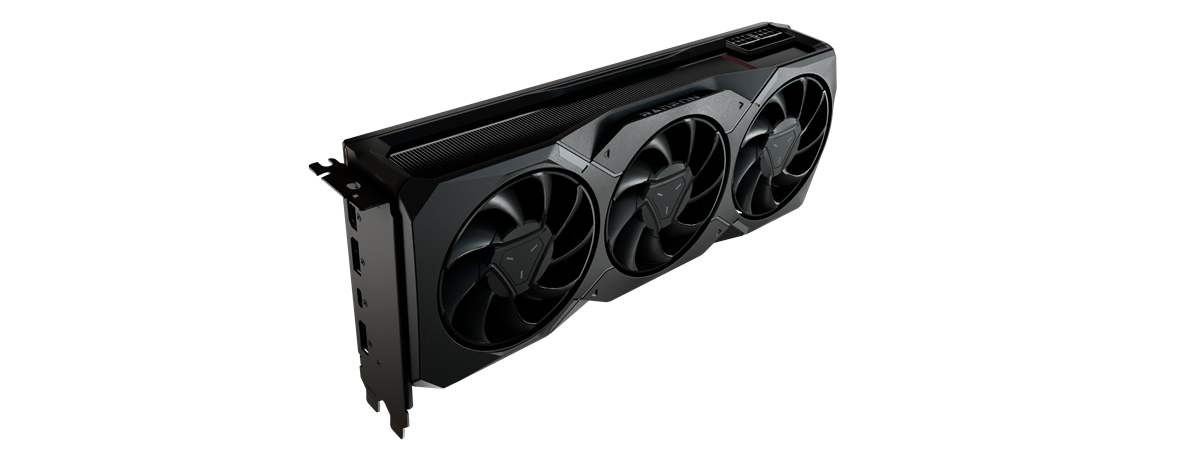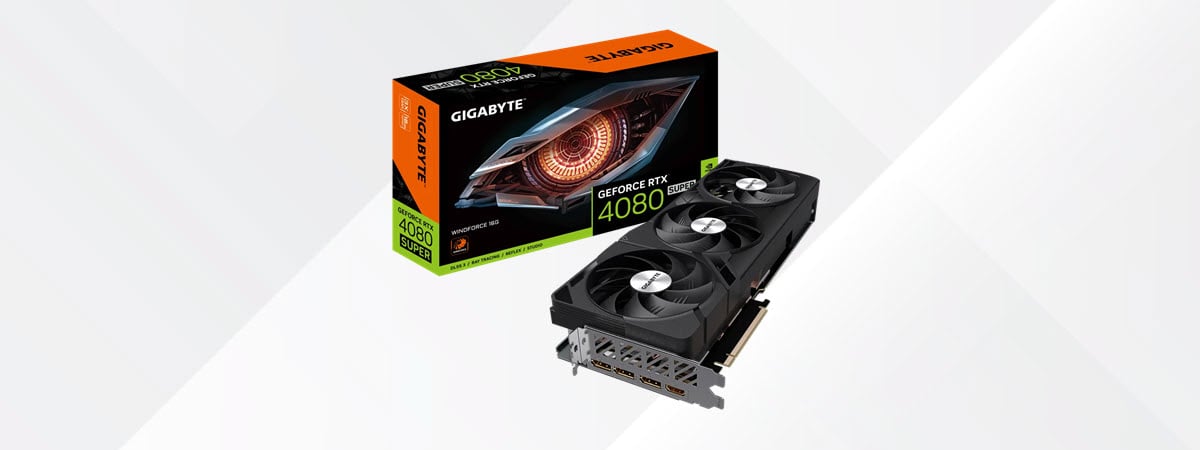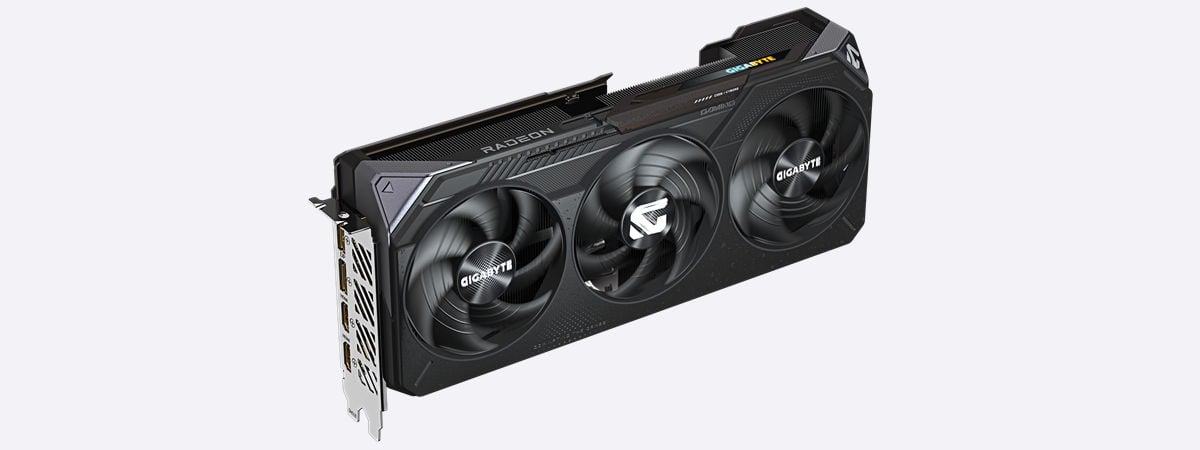
The GIGABYTE Radeon RX 9070 XT GAMING OC 16G graphics card is one of the top models based on the latest RDNA 4 architecture from AMD, promising high-quality gaming experiences at both 1440p and 4K resolutions. Featuring significant advancements in ray tracing, paired with cooling enhancements (via the WINDFORCE triple-fan system) and great build quality, this card competes directly with NVIDIA’s GeForce RTX 5070 Ti and other Radeon RX 9070 XT versions like ASUS PRIME and ASRock Steel Legend. While its hardware specifications and features make it sound awesome, is GIGABYTE’s Radeon RX 9070 XT GAMING OC 16G a good choice for gamers on the lookout for great performance without premium pricing?
GIGABYTE Radeon RX 9070 XT GAMING OC 16G: Who is it good for?
This graphics card is an ideal pick for gamers who want:
- Excellent gaming performance in resolutions up to 4K
- Improved ray tracing capabilities with AMD’s latest tech
- A graphics card that doesn’t generate a lot of noise
Pros and cons
Here’s what I appreciate about the GIGABYTE Radeon RX 9070 XT GAMING OC 16G:
- Outstanding, performance in resolutions up to 4K
- Substantial improvement in ray tracing compared to previous AMD Radeon generations
- Quiet operation and excellent thermal management
- Generous 16 GB GDDR6 VRAM
- Robust build quality with a sturdy metal backplate
- At 288 mm in length, it’s shorter than similar models from other manufacturers
As for downsides:
- Still trails NVIDIA in intensive ray tracing scenarios
- Its launch pricing is far from AMD’s suggested MSRP

Verdict
The GIGABYTE Radeon RX 9070 XT GAMING OC is a great graphics card - all the benchmarks and games I’ve run with it confirm that. It manages to surpass other implementations of the Radeon RX 9070 XT GPU, like the ASUS PRIME model that I reviewed a while back, delivering exceptional rasterized performance and substantially narrowing NVIDIA’s lead in ray tracing. While NVIDIA’s GeForce RTX 5070 Ti still holds an edge in ray-tracing performance, the GIGABYTE Radeon RX 9070 XT GAMING OC 16G offers a better price-to-performance ratio. Furthermore, its robust cooling solution keeps temperatures impressively low. All these put together make this GPU a superb choice for gamers aiming for high framerates at 1440p resolutions or those who want mid-level 4K gaming performance. The only major downside of this graphics card is its limited availability, and its initial launch price, which tends to be a lot higher than the $599 MSRP.
Unboxing the GIGABYTE Radeon RX 9070 XT GAMING OC 16G
Unboxing the GIGABYTE Radeon RX 9070 XT GAMING OC is straightforward yet satisfying. The packaging is sturdy, featuring a large sci-fi-looking illustration in black and blue, alongside the product name and some of its most important characteristics.
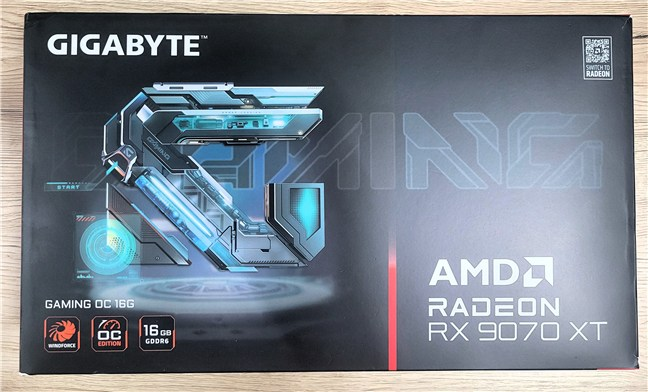
The packaging features a sci-fi design in black and blue
Inside, the card is securely protected by thick foam padding and an anti-static bag. Included is only a quick installation guide.
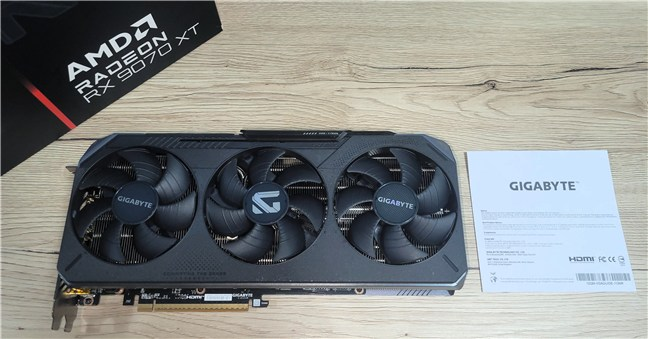
There's nothing bundled with the GPU
GIGABYTE’s packaging is minimalistic but entirely functional, prioritizing protection over flashy extras.
Design and hardware specifications
Built on AMD’s advanced RDNA 4 architecture, GIGABYTE’s Radeon RX 9070 XT GAMING OC 16G offers 64 Compute Units (CUs), boosting up to 3060 MHz. That’s slightly higher than ASUS PRIME’s 3010 MHz, for instance, and significantly more than the standard 2970 MHz that AMD references for the Radeon RX 9070 XT. The card integrates sixty four third-generation Ray Accelerators and 128 second-generation AI Accelerators, enhancing ray tracing and upscaling performance. Oh, and it includes 128 Render Output Units (ROPs) for efficiently handling demanding visuals.
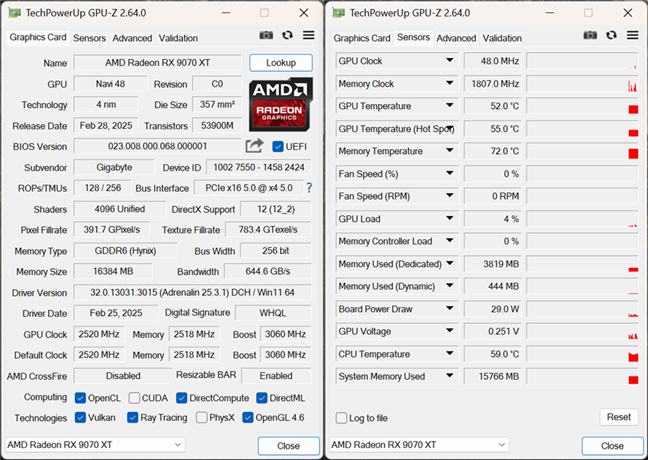
The specs of the GIGABYTE Radeon RX 9070 XT GAMING OC 16G
Memory-wise, the card boasts 16GB of GDDR6 RAM running at 20 Gbps on a 256-bit interface, providing 640 GB/s bandwidth. It also includes a 64 MB Infinity Cache to enhance effective bandwidth and reduce latency, which is important for 4K gaming.
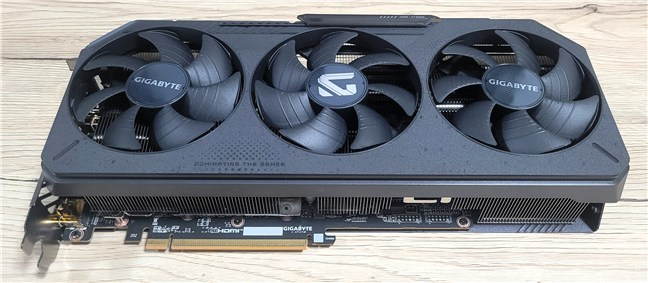
The GIGABYTE Radeon RX 9070 XT GAMING OC 16G has 16 GB of memory
The GIGABYTE Radeon RX 9070 XT has a 2.8-slot design (56 mm or 2.4 in thickness) and is a fairly long card with a length of about 288 mm (11.34 inches). Still, that’s actually shorter than many other Radeon RX 9070 XTs I’ve seen lately, including ASUS’ Prime Radeon RX 9070 XT, for example.
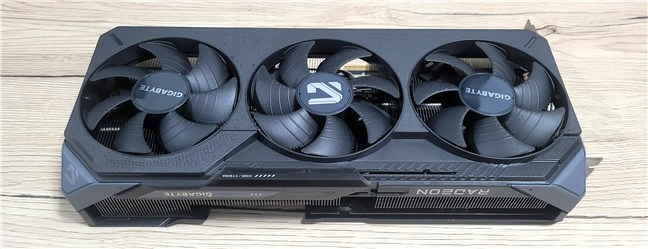
This GPU is shorter than similar Radeon RX 9070 XT cards
The card features three fans, which use GIGABYTE’s alternate spinning WINDFORCE design to reduce turbulence. Hidden underneath, is a large heatsink array with several composite copper heat pipes making direct contact with the GPU.
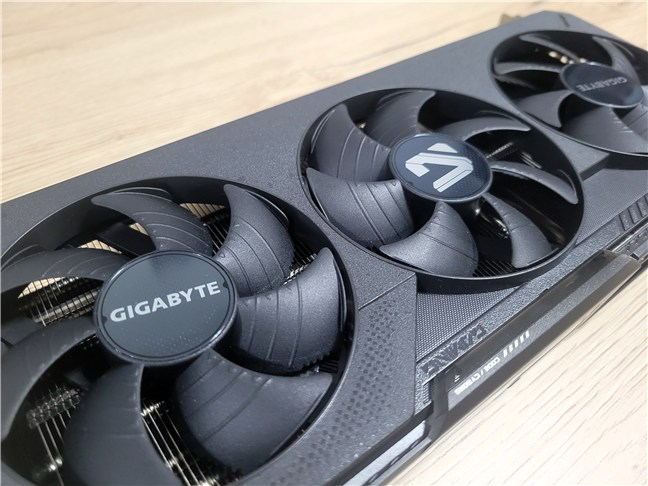
The GPU is cooled by a triple-fan WINDFORCE system
In terms of construction, this graphics card sports a matte black shroud with subtle gray accents, which is a fairly subdued look compared to flashier RGB-laden designs. That’s not to say that you don’t get any RGB because you do: on the side of the card, there’s a GIGABYTE text that lights up in any color you want.
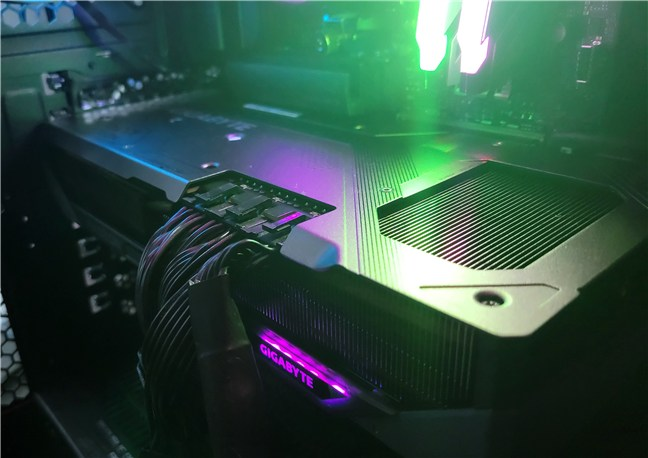
There's only a small RGB area on the side
It also features a full-length metal backplate that adds rigidity and helps with heat dissipation for the rear of the PCB. Build quality feels solid; there’s minimal flex, thanks to the reinforced frame.
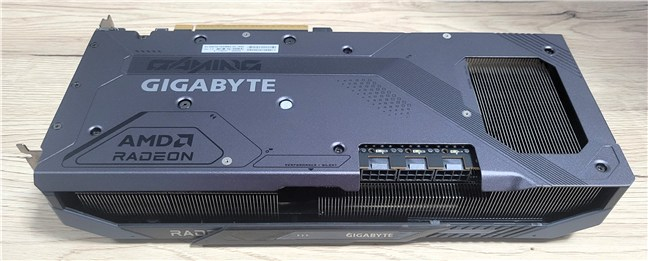
The backplate is solid and looks great
For power, this Radeon RX 9070 XT uses three 8-pin PCIe connectors recessed into the end of the card, and GIGABYTE recommends an 850 Watts PSU (power supply unit).
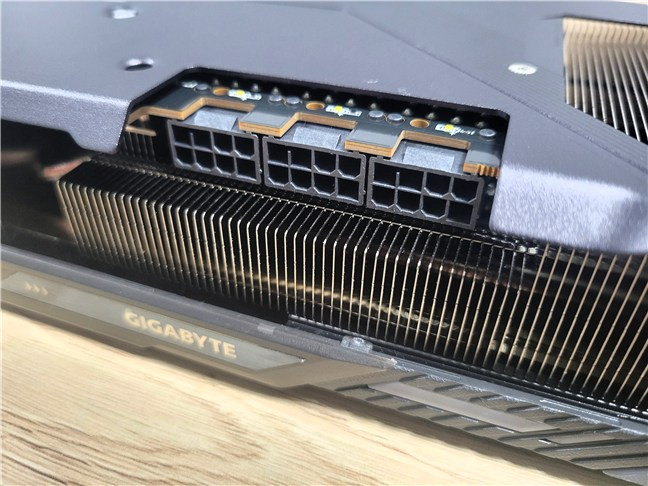
The GPU requires 3 PCIe power connectors
For connectivity, GIGABYTE provides two DisplayPort 2.1a and two HDMI 2.1b ports, allowing up to four simultaneous displays with resolutions up to 8K (7680 x 4320 pixels). Last but not least, it’s worth mentioning that the graphics card is also equipped with Dual BIOS (and a physical switch on the top edge) offering a choice between the default OC BIOS and a quiet mode. This is a feature that PC enthusiasts will certainly appreciate.
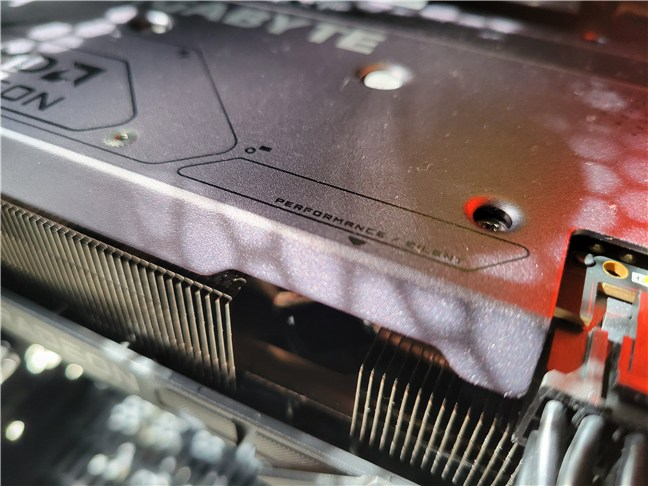
The card has a Performance/Silent switch
If you want more details about this graphics card’s hardware specs and features, visit its official webpage: GIGABYTE Radeon RX 9070 XT GAMING OC 16G Specification.
Overall, the GIGABYTE Radeon RX 9070 XT GAMING OC is exceptionally built and thoroughly equipped for mid-range to high-end gaming.
Using the GIGABYTE Radeon RX 9070 XT Gaming OC 16G
After installing the GIGABYTE Radeon RX 9070 XT Gaming OC 16G inside my computer, I wanted to see how well it performed in everyday tasks, not just gaming tests. But before that, here’s what my testing setup included:
- Motherboard: ASUS ProArt X870E-CREATOR WIFI
- Processor: AMD Ryzen 9 9900X
- Cooler: Cooler Master MasterLiquid ML360R RGB
- Memory: Kingston Fury Renegade RGB DDR5-8000
- Storage: Kingston KC3000 PCIe 4.0 NVMe M.2 SSD 2TB
- PSU: Seasonic Focus GX-1000
Using the GIGABYTE Radeon RX 9070 XT daily was very pleasant. The installation was simple since its length of 288 mm easily fits in any mid-sized ATX case. The card doesn’t come with a support bracket, but thanks to its robust construction and metal backplate, it remains sturdy without any noticeable sag. Once installed, the card had enough space and didn’t block cables.
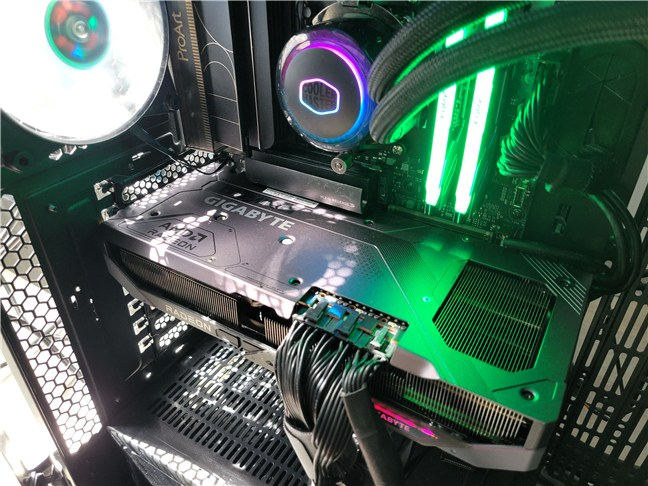
The GPU mounted in my test system
During testing, I paired the graphics card with the GIGABYTE MO32U Gaming Monitor. This 32-inch 4K monitor greatly enhanced my gaming experience. Its sharp resolution, vibrant colors, and quick response time (0.03 ms) provided beautiful visuals in every game I played. The high refresh rate (165 Hz) and support for FreeSync Premium Pro ensured smooth gameplay without tearing or stuttering. The MO32U is an excellent match for the Radeon RX 9070 XT and an ideal choice for gamers and creators alike.
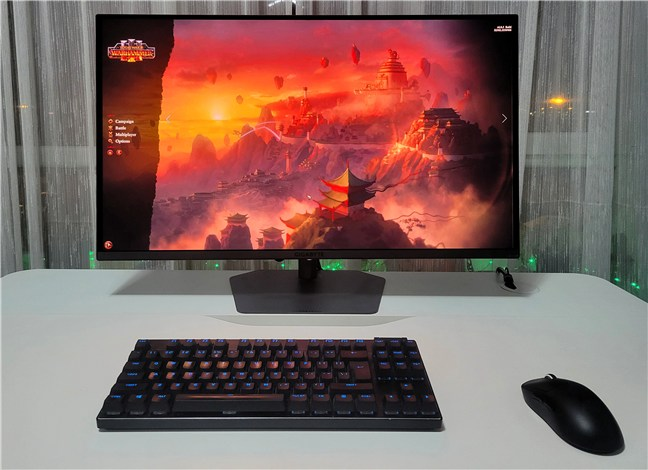
The monitor used while testing this card is gorgeous
Everyday use with the Radeon RX 9070 XT was smooth. AMD’s latest drivers were reliable, and features like Radeon Super Resolution and built-in performance tuning worked great. The card supports modern features from AMD’s RDNA 4, including AV1 encoding, which is helpful for streaming and video tasks. Although NVIDIA still leads in certain creative applications, the Radeon RX 9070 XT should handle most tasks with ease. While I don’t work with video editing applications or similar software, I do quite a lot of gaming. 🙂 And the experience this GIGABYTE GPU offered me was trouble-free, with no strange noises or unexpected fan behavior. Even under heavy gaming loads, like playing Star Wars Outlaws at 4K and maxed visual quality, the fans didn’t become noisy when they ramped up.

Playing Star Wars Outlaws
In short, the GIGABYTE Radeon RX 9070 XT Gaming OC 16G offers excellent performance, quiet operation, and ease of use, making it an outstanding choice for serious gamers.
Performance in games and benchmarks
I wanted to clearly understand how powerful the GIGABYTE Radeon RX 9070 XT Gaming OC 16G was for gaming, so I ran multiple benchmarks at ultra-quality graphics settings, enabling ray tracing whenever supported. To put its performance into perspective, I compared it to other cards, including the ASUS PRIME Radeon RX 9070 XT, the more budget-oriented ASRock Radeon RX 9070 Steel Legend, and a direct competitor from the other party (NVIDIA): the ASUS PRIME GeForce RTX 5070 Ti.
During my testing, I used each game’s highest graphics preset and enabled ray tracing at the maximum available quality setting. I deliberately avoided using FSR or DLSS, so that the results would represent each card’s true native performance without the aid of upscaling or image reconstruction.
In Cyberpunk 2077, the GIGABYTE Radeon RX 9070 XT consistently delivers superior performance among the Radeon-based cards. At 4K resolution, it slightly edges out the ASUS PRIME Radeon RX 9070 XT by about 4%, and notably outperforms the ASRock Radeon RX 9070 Steel Legend by 23.8%. However, compared to ASUS PRIME GeForce RTX 5070 Ti, it trails significantly at 4K resolution, performing 16.1% slower. At 1440p, the GIGABYTE GPU manages to be around 2% faster than the ASUS PRIME Radeon RX 9070 XT, 20.5% faster than ASRock’s Steel Legend, but still notably behind the GeForce RTX 5070 Ti by about 13.1%.
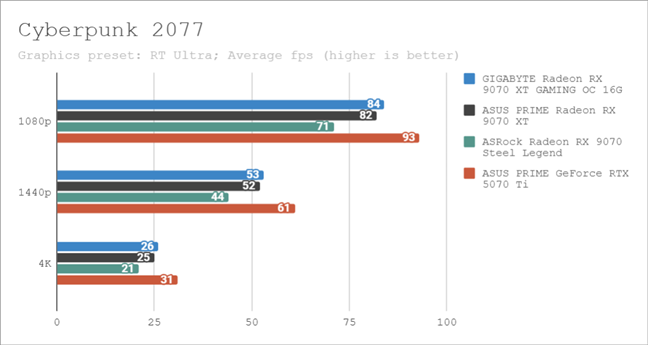
Benchmark results in Cyberpunk 2077
In The Callisto Protocol, at 4K resolution, the GIGABYTE Radeon RX 9070 XT outperforms the ASUS PRIME Radeon RX 9070 XT by 7.3% and significantly surpasses the ASRock Steel Legend by 15.7%, matching exactly the ASUS PRIME GeForce RTX 5070 Ti. At 1440p, it is in the lead again, being 5.2% faster than the ASUS PRIME Radeon RX 9070 XT, 12.1% faster than ASRock’s Steel Legend, and 10.9% faster than the GeForce RTX 5070 Ti.
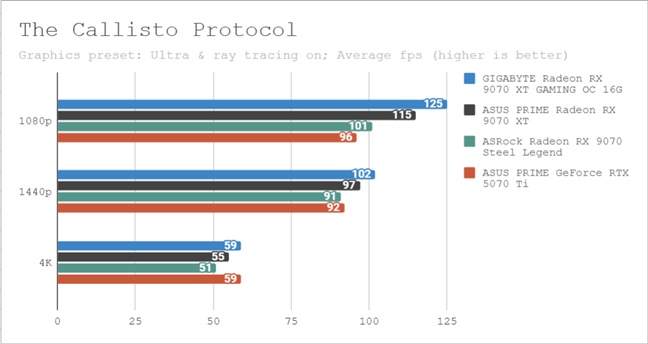
Benchmark results in The Callisto Protocol
Next, The Witcher 3: Wild Hunt Next-Gen Update. Here, the GIGABYTE Radeon RX 9070 XT provides excellent results at 4K resolution, performing 6.9% faster than ASUS PRIME Radeon RX 9070 XT, and 19.2% faster than ASRock Radeon RX 9070 Steel Legend, although it trails behind the GeForce RTX 5070 Ti by 6.1%. At 1440p, it’s ahead by 5.7% compared to ASUS PRIME Radeon RX 9070 XT and substantially leads the ASRock Steel Legend by 19.1% but remains behind the GeForce RTX 5070 Ti by 11.1%.
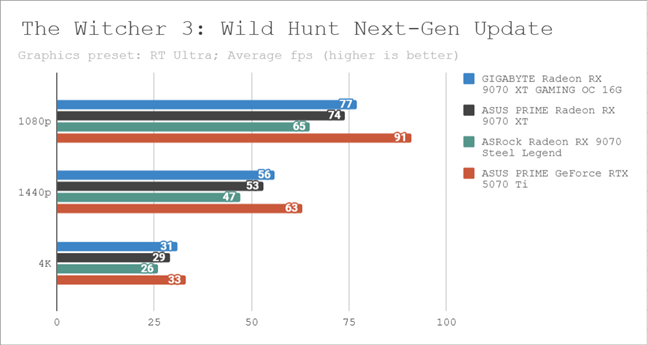
Benchmark results in The Witcher 3: Wild Hunt Next-Gen Update
In Total War: WARHAMMER III at 4K, the GIGABYTE card exceeds its ASUS counterpart by 2.6%, significantly surpasses ASRock’s GPU by 12.9%, and outperforms the GeForce RTX 5070 Ti by 2.6%, showcasing remarkable performance. At 1440p, it maintains the lead, outperforming ASUS PRIME Radeon RX 9070 XT by 2%, ASRock’s Radeon RX 9070 by 14.2%, and the GeForce RTX 5070 Ti by 9.3%.
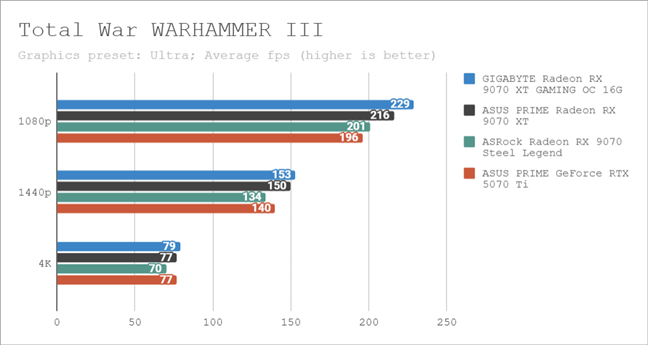
Benchmark results in Total War WARHAMMER III
In Assassin’s Creed Mirage, the GIGABYTE Radeon RX 9070 XT Gaming OC 16G consistently tops the performance charts in almost all resolutions, and it really stands out at 1440p and 4K resolutions. At 1440p, it is about 1.3% faster than the next closest card (ASUS PRIME Radeon RX 9070 XT) and up to 15.8% ahead of the slower competitors. Moving to 4K, the GIGABYTE card is second best, roughly 2% slower than ASUS PRIME Radeon RX 9070 XT, but faster than the other two remaining cards by about 4% to 12%.
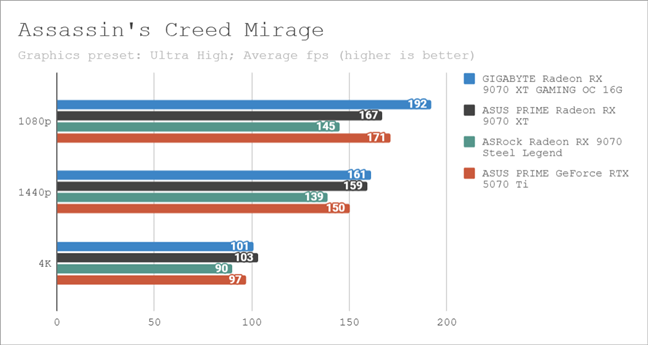
Benchmark results in Assassin's Creed Mirage
In Resident Evil Village, too, the GIGABYTE Radeon RX 9070 XT delivers strong performance, particularly at 1440p and 4K resolutions. At 1440p, it reaches 182 fps, which makes it about 3% faster than the ASUS PRIME Radeon RX 9070 XT at 177 fps and 17% faster than the ASRock Radeon RX 9070 Steel Legend. However, the ASUS PRIME GeForce RTX 5070 Ti outmatches all the Radeon cards at this resolution, putting the GIGABYTE card about 7% behind. At 4K resolution, the GIGABYTE card is neck and neck with the ASUS PRIME Radeon RX 9070 XT and roughly 10% ahead of the ASRock Radeon RX 9070 card. Still, it lags behind the GeForce RTX 5070 Ti, which leads and proves 15% faster. While the GIGABYTE card doesn’t claim the top spot in this title, it offers solid performance and shows better results than its RDNA4 siblings.
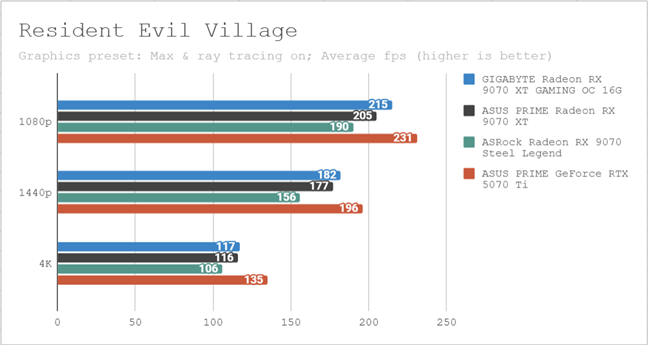
Benchmark results in Resident Evil Village
In F1 22, at 1440p, the GIGABYTE Radeon RX 9070 XT is roughly 1% ahead of the nearest contender (the GeForce RTX 5070 Ti) and up to 20% faster than the slowest option (the Radeon RX 9070). At 4K, it maintains about a 1% lead over the next-best card (again, the GeForce RTX 5070 Ti) and stands roughly 22% above the slowest result. This steady edge at higher resolutions highlights its strong overall performance in F1 22.
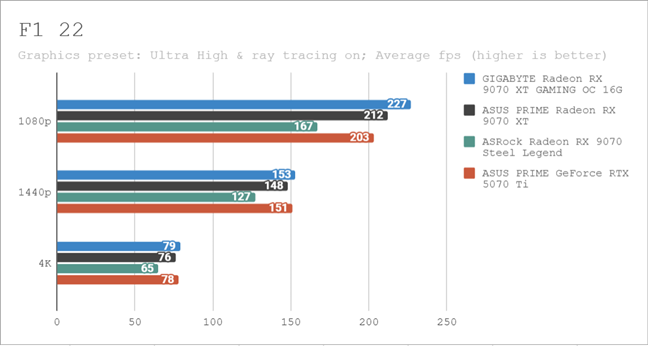
Benchmark results in F1 22
The last game I tested was Starfield: at 1440p resolution, the GIGABYTE Radeon RX 9070 XT Gaming OC 16G leads by about 9% over its closest rival and up to 12% over the slowest card. At 4K, it maintains a narrower edge of roughly 1% above the nearest competitor (the ASUS PRIME Radeon RX 9070 XT) and around 13% beyond the lowest performer. In this particular title, the GIGABYTE Radeon RX 9070 XT Gaming OC was the best of the best at all resolutions tested.
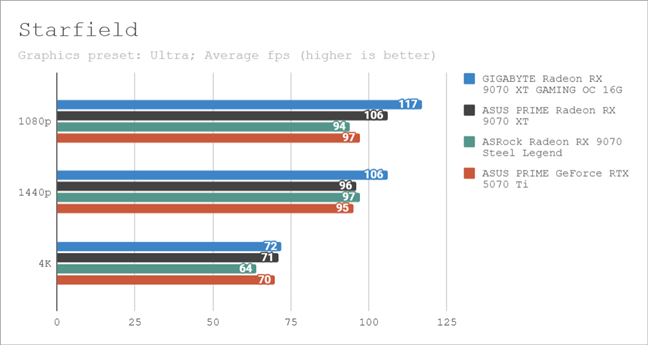
Benchmark results in Starfield
Next, I moved on to run a couple of synthetic benchmarks offered by the well-known 3DMark software. I ran Time Spy Extreme - a DirectX 12 benchmark for AAA gaming conditions, Speed Way - which focuses on advanced ray tracing and lighting effects to measure next-generation features, and Port Royal - tests ray tracing performance to show how well GPUs handle complex reflections and global illumination. In Time Spy Extreme, the GIGABYTE Radeon RX 9070 XT Gaming OC 16G is around 3% ahead of its nearest AMD competitor (the ASUS PRIME Radeon RX 9070 XT) and 7% above the GeForce RTX 5070 Ti, while also outpacing the slower Radeon RX 9070 card by about 12%. In Speed Way, it falls behind the GeForce RTX 5070 Ti by roughly 17% but still stays ahead of its AMD peers by 3% to 12%. In Port Royal, it trails the GeForce RTX 5070 Ti by about 3% yet beats the second-fastest AMD Radeon RX 9070 XT card by 3% and outperforms the slowest by around 18%. Taken together, these three tests provide a well-rounded picture of how the GIGABYTE card handles both traditional DirectX 12 features and the latest ray-tracing requirements in modern games. In short, it offers top-notch performance in rasterization and solid results in ray tracing, although it’s still slightly behind NVIDIA.
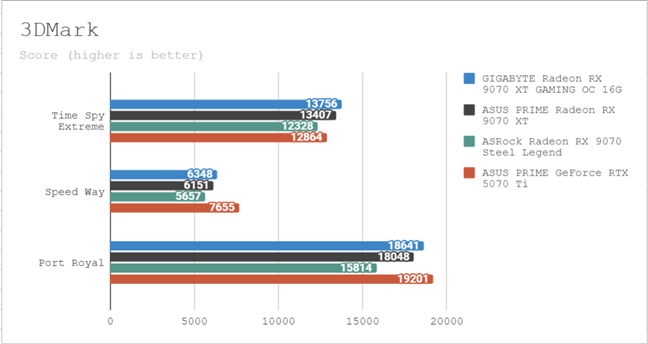
Benchmark results in 3DMark
A lower temperature generally indicates more efficient cooling and reduced potential for thermal throttling. At 67°C (152.6℉), the GIGABYTE Radeon RX 9070 XT Gaming OC 16G runs about 5% warmer than the ASUS PRIME Radeon RX 9070 XT and roughly 12% above the coolest card: ASRock Radeon RX 9070 Steel Legend. However, it is still around 8% cooler than the hottest GPU in the lineup, the GeForce RTX 5070 Ti. This places the GIGABYTE model near the middle of the pack while maintaining acceptable thermals under load.
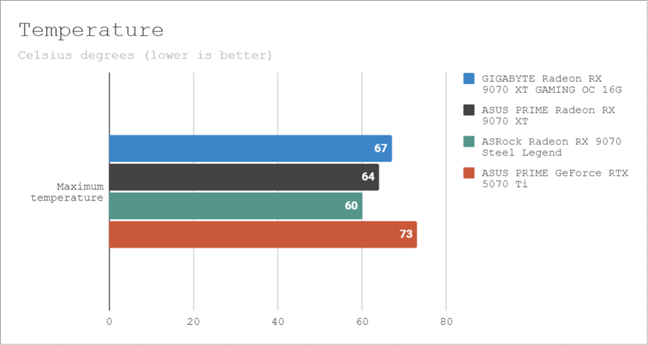
Maximum temperature readings
In terms of power consumption, the GIGABYTE Radeon RX 9070 XT Gaming OC 16G sits at 330 W, roughly 4% higher than the ASUS PRIME Radeon 9070 XT at 316 W, 9% above the GeForce RTX 5070 Ti at 302 W, and 35% above the ASRock model at 245 W. This positions the GIGABYTE card as the most power-hungry option in the lineup, though its slightly higher consumption is a small trade-off for its robust performance.
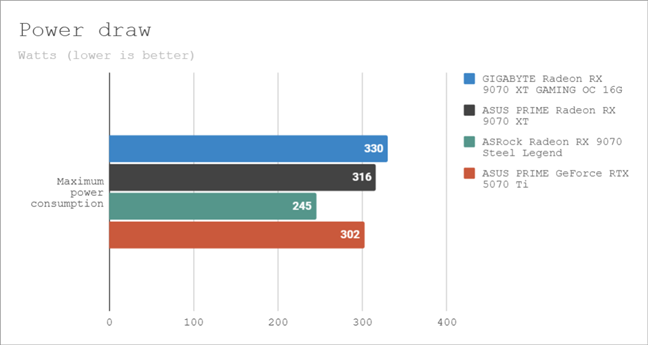
Highest power draw recorded
Overall, the GIGABYTE Radeon RX 9070 XT Gaming OC 16G offers exceptional performance in both games and synthetic benchmarks, often defeating the other cards on the list. It uses the same core GPU as the ASUS PRIME Radeon RX 9070 XT but has a slightly higher factory overclock, which leads to better results. The downside is a bit more power use, but that may be worth it for users who want top performance.
What’s your opinion about the GIGABYTE Radeon RX 9070 XT Gaming OC 16G?
All things considered, the GIGABYTE Radeon RX 9070 XT Gaming OC 16G delivers remarkable results in most scenarios. Its top-notch results in both gaming and synthetic tests, coupled with an excellent cooling system, make it an attractive choice for gamers and enthusiasts who want high performance. Although it demands a bit more power than some alternatives, it often delivers the frame rates to match. If you are looking for a powerful GPU that can handle today’s demanding titles at high resolutions, the GIGABYTE Radeon RX 9070 XT Gaming OC 16G is definitely worth considering. Do you agree? Let me know in the comments section below.


 28.03.2025
28.03.2025 